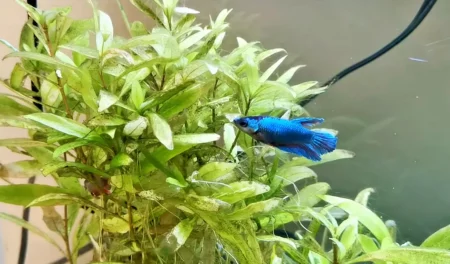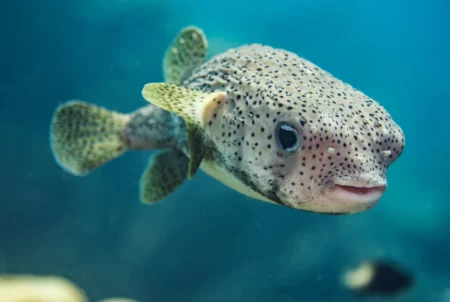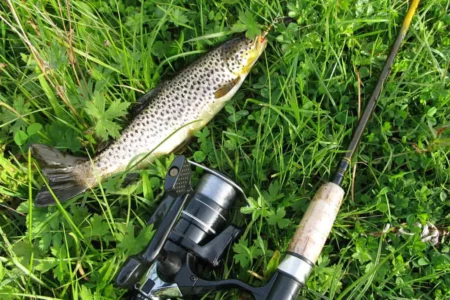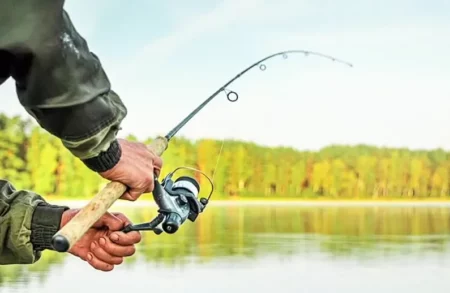Many people love fishing. The serenity and sense of connecting directly with Mother Nature is amazing. But fishing isn’t as basic as it used to be during our ancestors who lived in caves. People don’t use their spears to catch fish anymore. As the years have gone by, we have come up with better technical methods to catch all kinds of fish.
The fishing approach using a Baitcaster Reel can get a person a little overwhelmed because of its difficulty level as compared to the Spinning Reel. Learning how to use Baitcaster Reels will up your fishing game. We will run you through all the basic steps and make sure that you know how to use a Baitcaster reel by the end of this article.
Learning how to use a baitcaster will enhance your skills and improve your reputation among your fishing companions. Using a baitcaster reel may not be very easy, but it will help you catch bigger fish in various conditions.
Before we move on, let’s see how a Baitcaster reel is different from a Spinning reel.
Related Also: Best Baitcasting Reels Under $100
Baitcasting Reel VS Spinning Reel
A Spinning Reel is somewhat of basic equipment most people will pick when they start fishing. A Spinning reel has an open spool, which gives it a basic look. The backlash risk on the Spinning reel is low, making it much easier to use. The spinning reel is capable of catching small or medium fish. They are easy to maintain and are cheaper, but their durability is lower than a Baitcaster reel.
On the other hand, a Baitcaster Reel uses an inline spool design and can cast at a different spot with great precision. It can carry heavily weighted lures and are also available in a high-speed gear ratio (lure retreatment speed). The baitcaster reels are highly durable too.
How to avoid baitcaster backlash? The risk of backlash is higher, the reel is harder to maintain, and they cost a bit more than the Spinning reel. Baitcaster Reels require greater skill and can also be used to catch bigger fish!

Checklist of items
First, you will need some essential items before learning how to use baitcaster reels.
Before we set out on our way to practically learn using the baitcaster, we need to make sure we have all the relevant items. Without surprise, you, of course, need a Baitcaster reel. There are various kinds of baitcaster reels available on the internet to use from. Baitcasting reels have graphite or aluminum body, EVA or golf handle grips, different gear ratios, and two kinds of reel designs.
- The first reel design is the traditional round one. It can hold a long length of line and is capable of a lot of power, and it requires good nourished skills.
- The second reel design is the low-profile reel. They are comparatively easier to handle and have a better visual look.
If you’re a newbie, then we would recommend you buy a low-profile style baitcaster reel design with an average gear ratio of 5:1 or 6:1.
There are tons of great manufacturers to choose from, and some prominent examples include; KastKing, Abu Garcia, and Piscifun.
You would need a fishing rod, to which you will attach your baitcaster reel. We suggest that you use a strong and well-built fishing rod. As long as you have a good Fishing rod, you will be able to put your baitcaster reel on it. Other than that, more no-brainer items are a sturdy line to wrap around your spool with that a bunch of different lures to catch various kinds of fish.
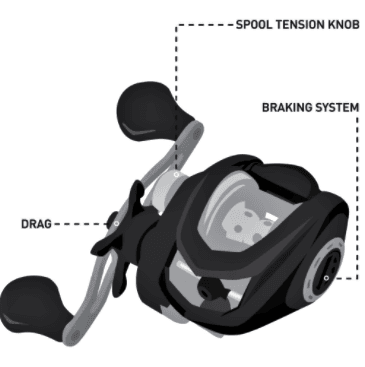
Functions of a Baitcaster Reel
It is very important to get familiar with all the details and specifications before practicing how to use Baitcaster reels. You will not fully immerse yourself and use the reel at its maximum capacity if you are unaware of its abilities.
The looks and details of a baitcasting reel may be a bit too much for a fisherman who uses a basic spinning reel. The cosmetics and functions are different from the spinning reel for bass. To make it easier for you, we will go through all the basic yet important portions of a Baitcaster reel so that you can easily cast your baitcasting reel and catch all the fish while you look like a pro!
A low-profile design reel of baitcaster reel will have the following components:
Drag System:
The Drag system or the Star Drag is a star-shaped dial or a knob attached right nice to the reel handle. It is conveniently placed in between the reel body and the handle. This dial adjusts the power by which a fish will be dragged or countered against its pull.
The drag system can either be set to loose or tight. Both of these have their gains and losses. A loosened setting will give the fish a chance to pull off the line if they get behind cover. A strong fish can snap the line up if the drag system is set too tight.
Thus, it is essential to practice and find the perfect level of Drag settings in different situations.
Spool Tension Dial:
Managing the spool tension is another key part while learning how to cast a Baitcaster reel. The spool rotation speed can be adjusted and varied in few different ways. One of them is by setting the spool tension. You can find the spool tension dial just above the Star Drag system knob.
What does the Spool Tension do? The spool tension dial helps set the speed by which the cast slows down just before hitting the water. Depending on the sensitivity setting, the spool will stop rotating just when the cast hits the water, and this may also prevent backlash.
The Spool tension adjusts the ending speed of the cast; the brakes should tune before. It is crucial to understand that the spool tension will react differently to the lure size and weight.
Centrifugal Brake Mechanism:
The spool tension dial was the first braking system we went through. Other than that, your Baitcaster reel could either have a Centrifugal brake system or a Magnet brake system.
The centrifugal brake system is located inside the reel, and to be able to alter this first, you will need to remove the side panel. You will notice a few small-sized clips inside; they can either be clicked outwards or inwards. Clicking them outwards will activate the brakes and will help in controlling the spool.
For newbies, it is suggested that the brakes should be activated at the beginning before they start fishing.
Magnet Brake Mechanism:
Another braking system that is common in some Baitcaster reels is the magnet brakes. The magnetic brake system has a dial on the opposite side of the reel’s handle. The dial can be adjusted, making the magnets move away from the spool or bring them closer to the spool.
If you turn the dial towards a higher number, the magnets will be moved closer to the spool, increasing the influence while casting and vice versa. A beginner should test the magnet brakes by setting them at full and then in the middle.
Thumb bar:
When you attach your reel to your rod before practicing how to use baitcaster rod and reel, you will notice a bar just beneath the spool. This is exactly where you will place your thumb naturally while fishing.
So, what does it do? When casting the lure, the thumb bar is pressed to release the line. When you push it down, the gears inside your spool are disengaged, which allows the reel to spin freely. The placement of the bar is convenient because, if needed, you can manually slow down the spool by placing your thumb on it.
Level Wind:
Level wind is the interjectory right beneath the spool. This part adjusts and manages the line that goes into the spool and rotates. The level wind interjects the line systematically, making sure no problems are created during it. It is an important part of a baitcaster reel. A broken level wind would end up in a lot of backlash or line tangling, so it should be taken care of and cleaned frequently.
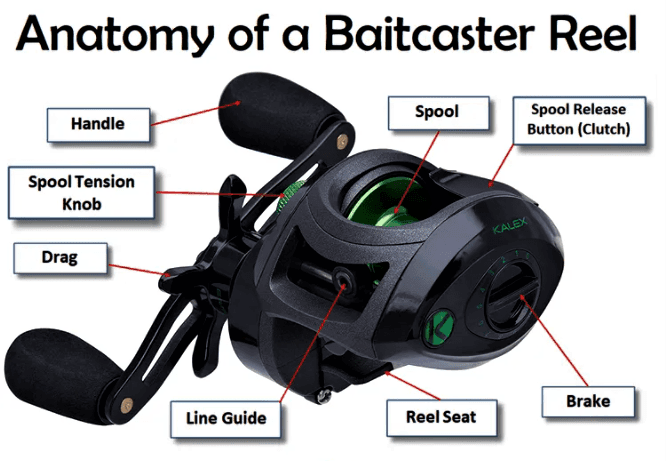
Setting up the Baitcaster Reel
We’ve gone through all the basic information before learning how to use Baitcaster reels. Now let’s work on it practically. Once you have everything you need, the first step in setting up is applying the spool line on.
Applying the Line:
Learning the application of spool lining is useful and will enhance your skills as a fisher even more. Fishing rods allow some lines to be tied as it is. If you end up getting a braided line, then you’ll need a supporting material with it too, like a tape so that it doesn’t slip, and then you can spool the braided line.
Make it go through all the small little holes along your rod until it reaches the level wind component. This is where it can get rather easy for you or a bit tricky. If your Spool has a guide hole, you can pass the line through it and rotate your handle. This will automatically apply the line on your spool and spread it evenly.
If your Spool doesn’t have holes in it, then you’ll have to do it all manually. You will have to insert the line through the front of the reel. This can be easier by using a tool to help make the line go through properly.
After the line reaches the spool, you need to tie an Arbor or an Albright knot. The knot should be tight. Then you need to apply tension and pressure on the knot and the line which is in front of the reel. Now you need to reel the line using the handle and maintaining the press on the line.
So now your line is all set and in place before you learn how to use your baitcaster reel. You need to make a few more adjustments.
Adjusting the Spool Tension:
The first adjustment you need to make to learn how to use a baitcaster is setting the Spool tension knob. This is utterly important because testing and adjusting this with each lure will decrease the chances of backlash. First up, you need to hold the rod slanting upwards. Then you will make sure that the lure is hanging a few inches below the tip. Now drop the lure while holding the spool with the thumb. You will keep doing this with different spool tension configurations. You might experience some line backlash, but you can easily repeat it since you’re just testing it. When you find the perfect setting for your specific lure, you are good to go ahead to the next step.
Brake Settings:
Regardless of the mechanism, your Baitcaster reel has either a centrifugal or magnetic. You will have to test them out, just like we tested the spool tension knob, in the same scenario after finding the right spool sensitivity settings.
You can either fully maximize the brakes on your baitcaster reel (by turning the dial to the highest number in a magnetic brake system or clicking all the clips outwards in a centrifugal brake system). After that, you can test it out on different settings and get used to the one which suits you. Lowering the brakes is a bit harder to control and is only recommended once you are used to baitcasting. For beginners, a medium setting would do alright. Test and find the perfect adjustments that make you feel the most comfortable.
Related Also: Best Ultralight Spinning Reel 2021
Drag System Rearrangement:
We went through this before the drag system determines how much drag is applied on the line while countering the fish. Unlike the other adjustments, the drag system can fully be tested when you hook a fish. So, it is essential to consider the factors under which you are fishing. By setting the drag option to lose, you can catch small fish with ease. By adjusting it to the right option, you can counter the prowess of a big fish.
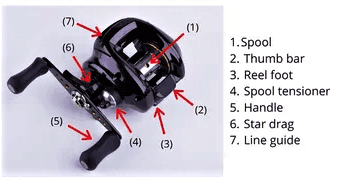
Casting a Baitcasting Reel
We’re more than halfway through learning how to use baitcaster fishing reels. Now the only hurdle left between you and endless successful fishing trips is casting your line. We will make sure you get through this hurdle with ease.
A simple tip before fishing is, you can easily safely practice your casting skills on flat ground. Using this tip, you will save time and learn much quicker.
First, you need to have a firm standing position and your fishing rod safely in your hand.
First, you will reel the lure until it’s hanging at least a foot down from the rod’s tip, depending on which side-oriented baitcaster you have. You will need to get a good grip around the rod and place your thumb right on the thumb bar below the spool. The excess rod beneath the reel should be resting on your forearm at this point.
Okay, the stance and position should be on point by now. You need to press the thumb bar while the edge of your thumb is resting on the spool line. Now cock your elbow backward, making the rod go above and behind your shoulder, then release and push it forward. At this point, the lure will be released, and the line will eject itself. You will be able to feel this against the tip of your thumb.
The force you push your fishing rod forward depends on the spot you want to throw your lure at. Before applying any force on your throw, you should also consider the weight of your lure.
This is the crucial part you will need to practice when the lure is about to hit the water. You need to press down on the spool line with the tip of your thumb to stop the line instantly. The timing is essential and needs to be worked on. This can improve your casting accuracy, and it will also prevent any backlash. If everything is done perfectly, you’re all done. That is how to use baitcaster reels!
After a good few tries of practicing, you will be good to grab your gear and head towards the nearest pond or river. Impress your fellow fishers with good controlled baitcasting skills.
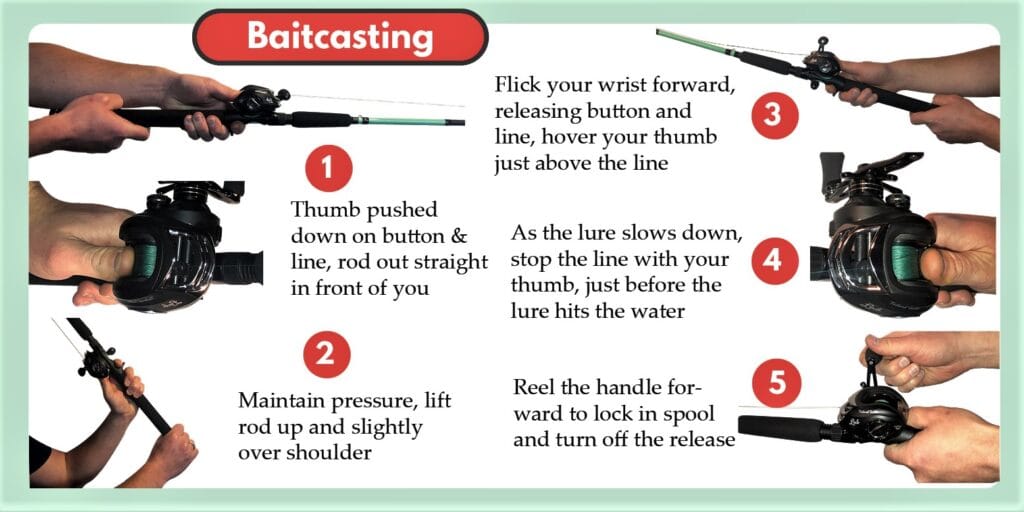
How to Clean a Baitcaster Reel?
You should clean and keep your baitcasting reel up to touch. Baitcasting reels are usually very durable, but if you handle it with extra care and clean it after your fishing sessions, that will surely enhance its life.
Tools like dry towels, cotton buds, toothbrushes, rubbing alcohol, and lubricants will do the job for you.
- A dry towel with a damp cloth can easily clean up the body of the reel. This will wipe off any dust on the frame of the baitcaster reel.
- By removing the cover, you can pull the spool out and gently clean it with rubbing alcohol.
- Separating the line and spool is also suggested and then cleaned with soap. Fishing in saltwater or a swamp can get the baitcaster dirty.
- Applying lubricants and oils before putting the spool back in will also enhance and smooth out its performance for the intricate minute parts of the reel.
- You will need to get a cotton bud dipped in rubbing alcohol.
- Then a simple rub in between tight spaces will clear out all the accumulated dust.
- If you have cushioned EVA handles, you can remove the paddings and clean the handle grips in warm water.
This routine of cleaning will keep your Baitcaster reel all clean and smooth. We guarantee you it will accompany you on your fishing journeys for many years to come!
Summary
Well, we hope you enjoyed and learned as much as we enjoyed typing out this in-depth guide on how to use Baitcaster reels. It may take some time to master the baitcaster. Once you do, you’ll experience fishing like never before. With all the relevant knowledge about all the parts and all the functions, with practical application too, we guarantee that your skills will amplify, and you will be an advanced fisher!

